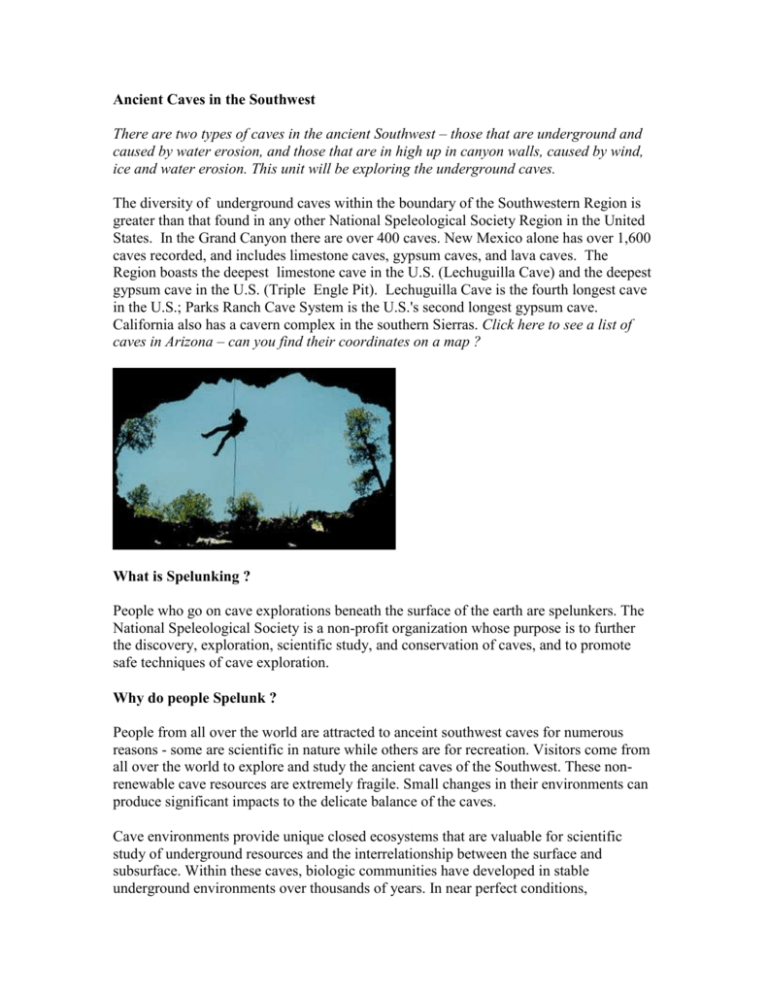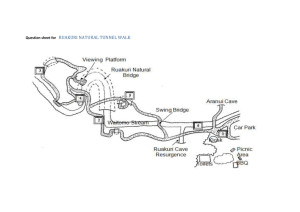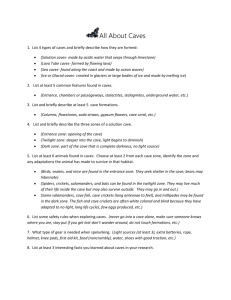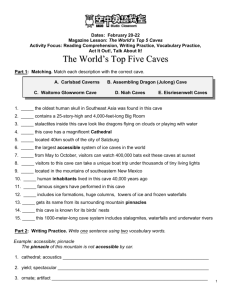Ancient Caves in the Southwest
advertisement

Ancient Caves in the Southwest There are two types of caves in the ancient Southwest – those that are underground and caused by water erosion, and those that are in high up in canyon walls, caused by wind, ice and water erosion. This unit will be exploring the underground caves. The diversity of underground caves within the boundary of the Southwestern Region is greater than that found in any other National Speleological Society Region in the United States. In the Grand Canyon there are over 400 caves. New Mexico alone has over 1,600 caves recorded, and includes limestone caves, gypsum caves, and lava caves. The Region boasts the deepest limestone cave in the U.S. (Lechuguilla Cave) and the deepest gypsum cave in the U.S. (Triple Engle Pit). Lechuguilla Cave is the fourth longest cave in the U.S.; Parks Ranch Cave System is the U.S.'s second longest gypsum cave. California also has a cavern complex in the southern Sierras. Click here to see a list of caves in Arizona – can you find their coordinates on a map ? What is Spelunking ? People who go on cave explorations beneath the surface of the earth are spelunkers. The National Speleological Society is a non-profit organization whose purpose is to further the discovery, exploration, scientific study, and conservation of caves, and to promote safe techniques of cave exploration. Why do people Spelunk ? People from all over the world are attracted to anceint southwest caves for numerous reasons - some are scientific in nature while others are for recreation. Visitors come from all over the world to explore and study the ancient caves of the Southwest. These nonrenewable cave resources are extremely fragile. Small changes in their environments can produce significant impacts to the delicate balance of the caves. Cave environments provide unique closed ecosystems that are valuable for scientific study of underground resources and the interrelationship between the surface and subsurface. Within these caves, biologic communities have developed in stable underground environments over thousands of years. In near perfect conditions, archeological and paleontologic resources are preserved in stable cave environments. Some of the paleontological remains date back to over 35 thousand years. The introduction of foreign substances or the creation of additional entrances can upset the delicate ecosystem balance. Mineral formations found in these caves are rare and fragile and are found in no other caves. Hence, it is important that these resources be preserved and protected. How are caves created ? Here is a proposed description of how Carlsbad Caverns was created as an example of a caves creation over a long period of time. Form the National Park Service. ONE THEORY None of us witnessed the formation of Carlsbad Cavern. And since time and conditions don't allow us to duplicate the process in a laboratory, we are left with theories based on puzzle pieces. One theory, simplistically stated is . . . A very long time ago, a shallow sea covered Carlsbad Cavern. Plants and animals lived and died in the sea. Their shells and skeletons piled on top of each other, making a reef. Over time, many layers piled up, squashing the shells and making the layers hard, compact and thick. Fossil of a chambered nautilus sea shell in Carlsbad Caverns The sea dried up causing the reef to be exposed to the air. Movements in the earth's crust pushed the reef upwards, forming a limestone mountain. Trees and other plants grew on the mountain, covering the old reef and causing cracks to develop in the limestone. Rainwater sank into the soil and went down through the plants' roots and finally down through the cracks in the limestone. On its way through the atmosphere and the soil, the water absorbed carbon dioxide. A weak acid was chemically formed when the water mixed with the carbon dioxide. The resulting carbonic acid dissolved the calcite in the limestone. At some point, large rocks in the cave ceiling fell. This opened up chambers, like the Cavern's Big Room — 25 stories high and a third of a mile wide. Carlsbad Caverns Big Room As water seeped and dripped its way into the Cavern, beautiful formations decorated the cave. SOLUBLE ROCK The largest and vast majority of caves are formed in soluble rocks — those that can be dissolved by a weak, natural acid. Limestone, dolomite, gypsum and marble are soluble rocks. Carlsbad Cavern, Lechuguilla Cave, Slaughter Canyon Cave and Mammoth Cave are all solutional caves. CAVE FORMATIONS A cave formation is a speleothem. The word comes from two Greek word — spelaion meaning cave and thema meaning deposit. Speleothems are mostly calcite, the same mineral that makes up limestone. When the water table lowers and air enters the cave conditions are right for the process of cave formations to begin. Slightly acidic water percolates through the limestone above the cave dissolving the calcite. When the water reaches the cave, calcite is redeposited. Two factors that influence the growth rate of the cave formations. TEMPERATURE. The outside temperature affects the rate of decay of plants and animals. The higher the temperature, the faster the decay. As the decay rate increases, so does the carbon dioxide in the soil. When high levels of carbon dioxide is present, the water flowing through the soil is more acidic. WATER. The more rainfall, the faster the growth. Two factors determine the shape of cave formations. HOW THE WATER ENTERS. Does the acidic water enter the cave by dripping, seeping or splashing? WHETHER THE WATER STANDS OR FLOWS. Mineral content determines the color of a cave formation. Pure calcite is white, almost colorless. Iron and other minerals combine with calcite crystals to add red, orange and black. Virtual Tours of Southwest Caves Colossal Cave, Arizona http://www.colossalcave.com/cavetour.html Carlsbad Caverns National Monument, New Mexico http://www.nps.gov/cave/home.htm California Caverns http://www.caverntours.com/default.htm John Muir on Caves From the Mountains of California "...we lingered and reveled, rejoicing to find so much music in stony silence, so much splendor in darkness, so many mansions in the depths of the mountains, buildings ever in process of construction, yet ever finished, developing from perfection to perfection, profusion without overabundance..." Photos courtesy National Park Service






